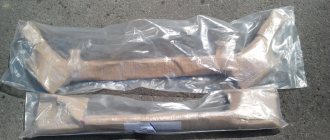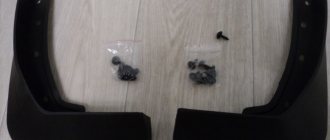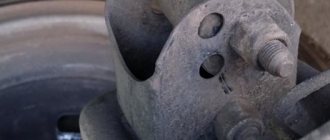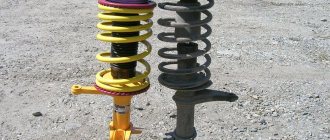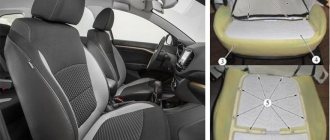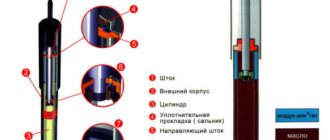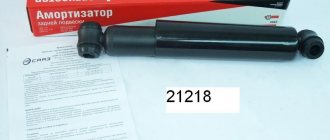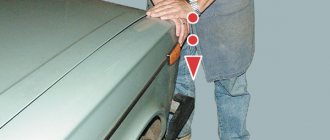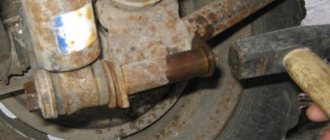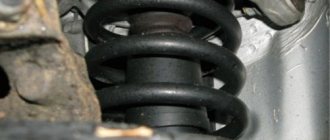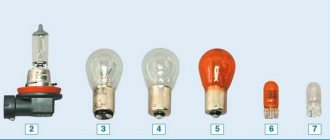For the first time, AvtoVAZ developed individual shock absorbers. They are installed only on Vesta. Drivers of Lada Vesta cars note the advantages of the brand. Among them are high ground clearance, sound insulation, and maneuverability. They also note a significant drawback of all Lada Vesta cars - knocking in the rear part of the suspension. The manufacturers said that a similar phenomenon occurred and explained that the extraneous sounds arise from the shock absorbers of the Vesta. To get rid of it, you just need to select washers of a certain size for the front supports for the struts, or you will need to overhaul the suspension and replace the part. When the time comes to replace it, you will need to look for original racks, or select them according to parameters from possible analogues. Read the article and your suspension will work smoothly and safely.
The shock absorbers installed on Vesta from the factory are the same regardless of the vehicle’s configuration. They are produced by a Russian plant. SAAZ struts are installed on the front and rear suspension of the Lada Vesta, which translates to: Skopinsky Automotive Aggregate Plant. There is a plant in the Ryazan region. They are gas, which differ from oil, or combined.
The two front parts are different. Therefore, the left and right spare parts are marked with an individual article number. Drivers note that the Lada's suspension is reliable; if the vehicle is used carefully, the shock absorbers will last a long time.
How to replace shock absorbers on a Lada Vesta yourself
Algorithm of actions for replacing the front struts
- Unscrew the wheel bolts;
- Remove the wheel;
- Raise the front of the car using a jack;
- Get the wires going to the speed sensors;
- Unscrew the nuts of the bolts securing the fist and remove it;
- Remove the windshield;
- Unscrew the bolts securing the part to the body;
- The spring is removed along with the strut;
- Installation of the new part is carried out in the reverse order.
The rear pillars are removed in the same way. The difference is that the spring is installed separately.
How to change struts on Vesta correctly
Initially, most car enthusiasts change suspension parts as they wear out. So, a replacement for the damaged element is purchased and the car is repaired. Perhaps in most units such actions are justified. When working with shock absorber struts, this sequence can cause more harm than savings.
Experienced craftsmen insist that the racks must be changed at least in pairs. This will help avoid increasing the load on the new part after its installation. Also, installing parts as a kit allows you to save time and money when visiting a service station.
The work of removing the front struts must be done on a jack: You will need keys for removing the wheel, a hexagon, a ring wrench, a set of new suspension: struts, springs, support bearing. Vesta suspension diagram.
- Using a balloon we loosen the wheel fastenings
- We jack up the car and completely remove the wheel from the hub.
- Next you need to remove the strut stabilizer. We unscrew the nut securing the stabilizer to the strut (No. 2), holding the stabilizer bar itself.
- Next, remove the speed sensor wire from the bracket on the body (No. 2 in the second picture)
- Then we release the steering knuckle: unscrew 2 nuts (No. 4) and a bolt (No. 6)
- We move into the engine compartment, remove the decorative trim on the pillar cup using a slotted screwdriver.
- Next, unscrew the 3 bolts securing the support to the body (No. 2 in the third picture)
- Remove the strut assembly with the spring. It is easiest to perform this operation with outside help.
How to install the front struts?
The racks must be installed in the reverse order. Having assembled the rack, install the wheel, lower the car to the ground and finally tighten the mounts of the rack support to the body cup. It is worth noting, an important factor, that after replacing the struts there is no need to do a wheel alignment.
Front struts
The chassis of the car has excellent shock absorbers. The right and left differ in some respects, although they have identical dimensions. Each of them has its own article number. If you need to replace the front struts of the Lada Vesta, you can look for original parts, or use analogues from other manufacturers. Among the proposed analog models there are options with a greater or lesser degree of noise in operation. Drivers trying to get rid of excessive noise should take this indicator into account when choosing a new part.
Manufacturers you can pay attention to:
- stellox;
- trialli;
- finwhale;
- SS-20;
- Asomi;
- Demfi.
Features of Vesta car shock absorbers
The front shock absorbers have the appearance of classic MacPherson struts and have the following characteristics:
| Catalog number | 8450006745 (left) 8450006744 (right) |
| Shock absorber type | Gas |
| Bottom mount | Eyelet + rubber-metal joint |
| Top mount | Stock |
| Rod diameter | 20 mm |
| Case diameter | 48.5 mm |
Factory racks Lada Vesta
The original shock absorbers for the Lada Vesta are unique in some sense. The manufacturer produced them specifically for the Lada Vesta. They were not installed on other AvtoVAZ models.
The manufacturer claims that this part, installed at the factory, will last 40-55,000 km. Factory parts can withstand this distance if the car is driven on a high-quality road surface under certain weather conditions.
The racks provide safety, reliability when moving on a vehicle, maneuverability, controllability, and smooth turns.
Removing and installing rear suspension springs of a Lada Vesta car
We place the car on the lift, apply the parking brake and turn off the ignition.
To prevent damage to the rubber-metal hinges of the rear suspension arms, it is not allowed to hang the rear suspension arms with the hinges tightened by an amount exceeding the position of the arms with the rear suspension springs completely unloaded.
Remove the rear wheel.
Raise the car to a comfortable height.
We install transmission rack 2 under lever 1, Figure 1, of the rear suspension and lower the car until the rear suspension spring begins to compress.
Using a 21 socket, unscrew bolt 3 securing shock absorber 4 to the rear suspension arm.
Raise the car until the rear suspension arm moves away from the transmission rack and remove spring 2, Figure 2, lower gasket 1 and upper gasket 2.
Installing springs
Install the lower spring gasket 2 on the levers 1, Figure 3, of the rear suspension, aligning the protrusions “A” on the gasket with the holes “B” on the levers.
Install the upper gasket 1 on the spring 2, Figure 2, of the rear suspension.
Install the spring assembly with the upper gasket on the rear suspension arms, aligning the end of the spring with the protrusion “C”, Figure 3, on the lower gasket 2. After installing the spring, make sure that the protrusions “A” of the gasket are located in the holes “B” of the rear suspension arms.
Lower the car until the rear suspension spring begins to compress, align the mounting holes in the shock absorber and the rear suspension arm and tighten the mounting bolt. The bolt tightening torque is 90 - 120 Nm (9.0 - 12.0 kgf.m).
Install the rear wheel.
How to understand that it’s time to change the struts
Malfunctions of the Lada Vesta chassis must be corrected in a timely manner. Certain signs indicate the presence of shock absorber malfunctions.
Signs of damage:
- increase in braking distance;
- there is no close contact of the tire with the road surface, especially when driving off-road;
- the car moves from side to side when performing maneuvers and overcoming uneven surfaces;
- traces of oil leakage.
Diagnostics of the degree of serviceability of shock-absorbing parts is checked during diagnostics on a bench using electronic devices. Normal performance of shock absorbers is from 50 to 85 percent. The difference between the indicators of the right and left is no more than 20.
Reviews and recommendations from Lada Vesta owners
| Positive | Negative |
| With a mileage of 38 thousand, strange sounds began to arise from the front suspension. It turned out that the racks were rattling and had already exhausted their service life. I decided to replace the original shock absorbers with the manufacturer Acomi. After I ordered on the official website, the manager immediately called back and clarified the details. The parcel arrived in Tula in 4 days, the details are as in the picture, packed in boxes. I’ve been riding the new shock absorbers for a month now, and so far I can’t say anything bad – they cope with unevenness and obstacles perfectly. | After replacing the original front struts with Acomi, the car began to handle worse. With the Saazov struts, it seemed to be more confused; I always knew how the car would behave in a given situation. Now, when cornering, the car sways a little and in a strong crosswind, strange vibrations are felt. The original shock absorbers were still better. On the plus side, I note that the new struts are a little quieter and give a smoother ride. |
| Three months ago I installed SS20 struts on my Vesta. They are much quieter and softer than their relatives, and they are a pleasure to drive. I go over potholes smoothly, even speed bumps are not a problem. Great product! I recommend! | Don't buy Finwhale! This is not Germany, as it says on the box, but the real China. I didn’t even drive 15 thousand on them - they rattled like mad! |
| In my opinion, the best shock absorbers for the Lada Vesta are Demfi. They are inexpensive, reliable and high quality, although a little harsh. I’ve been driving them off-road and in potholes for the second year now, no problems and the price is very reasonable. | For me, not only the service life of the struts is important, but also the comfort of control and in the cabin. The Russian SS20s are very disappointing in this regard, as they are even more rigid than the original ones. Every bump in the road is clearly felt in the cabin. This is despite the fact that I did not choose the sports version, but the softer one. I can imagine how it feels to drive sports models! |
| I work in delivery, so the factory suspension did not last long. When it came time to change the struts, the guys from the service station advised Demfi. Russian manufacturer, quite reliable and inexpensive. | I wanted to buy good racks for a Lada Vesta car. The Kayaba manufacturer was not available; they probably don’t produce shock absorbers for this car yet. The sellers persuaded us to use Trialli. To be honest, they didn't impress me. The car looks like jelly on them, it doesn’t listen well to the steering wheel and it even seems to me that the seating position has become lower. The factory racks were even better. |
Knocks and noises in the front suspension of Lada Vesta
- Many car enthusiasts note the appearance of a squeaking sound in the front axle area immediately after purchasing a car from a dealership. Driving through speed bumps turns into real hard labor. The culprit is the rubber bushings on the stabilizer bar.
Service station technicians do not recommend lubricating sealing products with grease or transmission oil. The creaking will go away, but for a short time, then it will resume again. To get rid of annoying squeaking, use polyurethane stabilizer bushings from Chevrolet Niva. (Cat. Art. 17012680).
- The play of the tip in the ball joint can also cause knocking. According to the regulations, replacement is carried out complete with suspension arms.
- Often inexperienced drivers confuse the creaking of suspension elements with a dull knock in the exhaust system area. The muffler mount is another defect from AvtoVAZ. The rubber retainer must be lubricated with silicone grease. The unpleasant sound will go away for a long time.
- The front suspension is knocking or rattling - contact a service station for help. Specialists identify the source of the breakdown with high accuracy. Self-diagnosis does not always bring the desired result due to the lack of special equipment.
- Do not forget that play in the chassis of the car can also be perceived as a malfunction in the suspension. Carry out diagnostics carefully and take a comprehensive approach to identifying the breakdown.
Wear of stabilizer bushings
If, when driving over a speed bump, a dull knock or squeak is heard from the front, there is a high probability that the reason for this is premature wear, due to the poor quality of the material, of the standard anti-roll bar bushings of the Lada Vesta - a malfunction typical of the VAZ sedan. In this case, other signs corresponding to the assumption should be present:
- knocking of the chassis when the car rolls while moving;
- beating in the steering wheel when driving on a flat surface at speeds above 60 km/h;
- increased play in the steering mechanism during intensive maneuvering;
- involuntary deviation of the car from straight-line movement.
The final conclusion will be made by inspecting the car on a car lift - if the bushings are swollen, have lost their geometry and elasticity, then they need to be replaced.
Replacing anti-roll bar bushings
If the dealer service center is remote and standard spare parts are available (catalog number: 8450006748), you can do this work yourself, with minimal risk of subsequent detection of independent intervention. After the warranty period has expired, or at the dealer, it is better to replace these parts with higher quality analogues, for example, polyurethane bushings from Lada Chevrolet Niva (article No. 17012680) or products from other manufacturers according to the dimensions indicated in the pictures.
To do the job you will need the following tool:
- TORX 40 angle wrench;
- ring wrenches “13” and “16”;
- 10" head with extension and wrench.
Work order:
- Using a 10mm socket with an extension, remove the protective cover of the steering mechanism;
- Using a 13mm spanner, remove the two rear bolts securing the steel brackets of the bushings;
- Using a T40 wrench, unscrew the front bolt securing one of the two brackets and remove the bracket;
- remove the old bushing from the stabilizer, clean and lubricate the hole in it with silicone grease, install a new bushing through the cut on it and first fix the steel bracket with the front bolt;
- replace the second bushing in the same way;
- tighten the 4 bracket fastening bolts with a force of 2.0-2.4 kgf m;
- Install the steering gear protective cover.
Replacement rear shock absorbers for Vesta
The factory rear struts go under the article number: 8450006786. The length of the rod is 12.5 mm. The case diameter is within 42 mm. You can increase performance characteristics by installing proven analogues, which include the following products:
Finwhale. 25057GU worth 1100 rubles.
Trialli. AG 01515 1500 rub.
Pilenga. SH-P 2712-G 1900 rub.
You can view products from other manufacturers. But these suppliers are more reliable and proven. Take into account driving performance and focus on cost.
Practical tips for choosing racks
After making sure that the shock absorbers are faulty, the driver needs to select a worthy replacement for the worn-out parts.
Some tips for choosing spare parts:
Pay attention to original products, or choose analogues from well-known and well-established manufacturers; Buy parts from large retail outlets that have quality certificates for their products and guarantee their originality. Do not buy spare parts on the market or secondhand. The cost of the shock absorber should not be too low
If the price differs significantly from other offers, most likely you are being offered a low-quality product. The shock absorber must be packaged in a separate box with the article number, catalog number and manufacturer's logo on it. Factory catalog number of rear shock absorbers 2180-2915004-12, front 8450006745 (left), 8450006744 (right).
Lada Vesta do-it-yourself replacement of stabilizer struts - when to change
Clear signs that it is time to replace the racks are.
- A characteristic knocking sound from the bottom of the car when driving over bumpy terrain. This is usually a sign of a completely damaged shock absorber. If you tighten it, it is possible to destroy the suspension units and body panels of the car.
- Increased rocking and roll of the car when passing high-speed turns. If the vehicle sways or tilts strongly when turning, there is a weakening of the rack’s efficiency.
- The appearance of oily stains on the shock absorber rod or in its immediate vicinity. Despite the fact that the struts are gas-filled, there is oil in them. Leakage of lubricant from the device body indicates damage to the seal. In the event of such a breakdown, the entire device should be replaced.
- The suspension becomes “plush”. Excessive softness of the car may indirectly indicate wear of the struts. At the same time, high-quality diagnostics are required - the cause of the problem may be hidden elsewhere.
- When rocking a part of the machine with your hands, the vibrations should subside immediately after the load is removed. If the body makes more than 1-2 oscillations after rocking, the strut is damaged.
